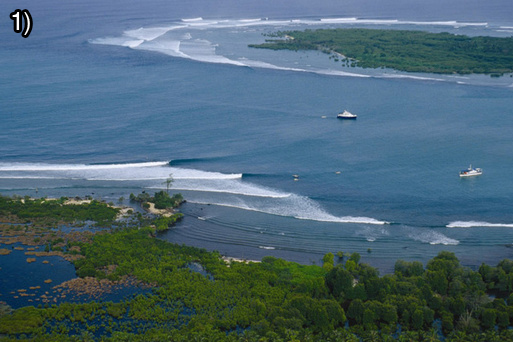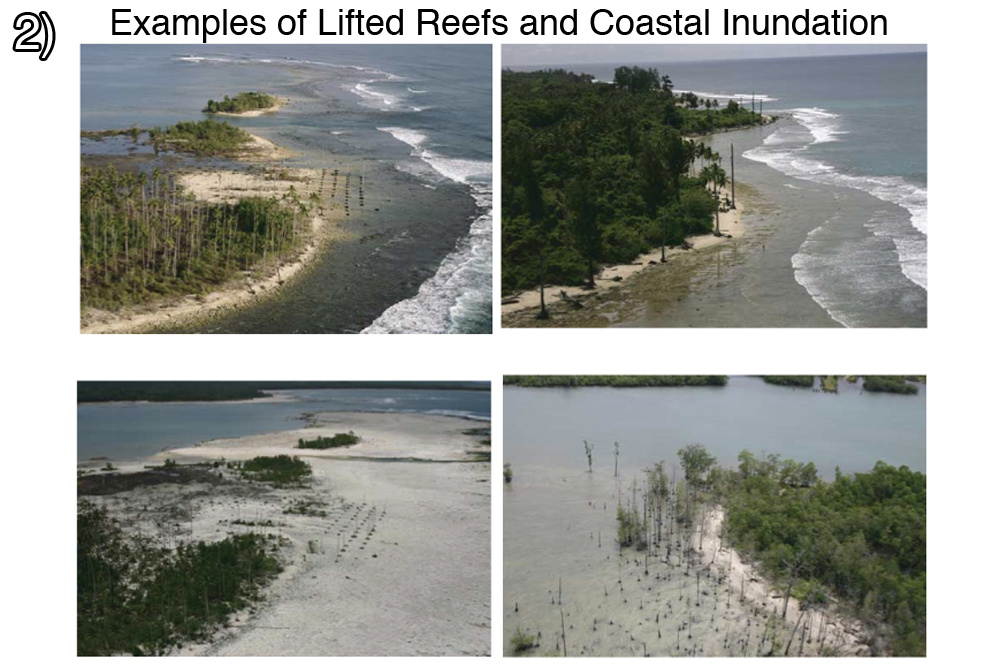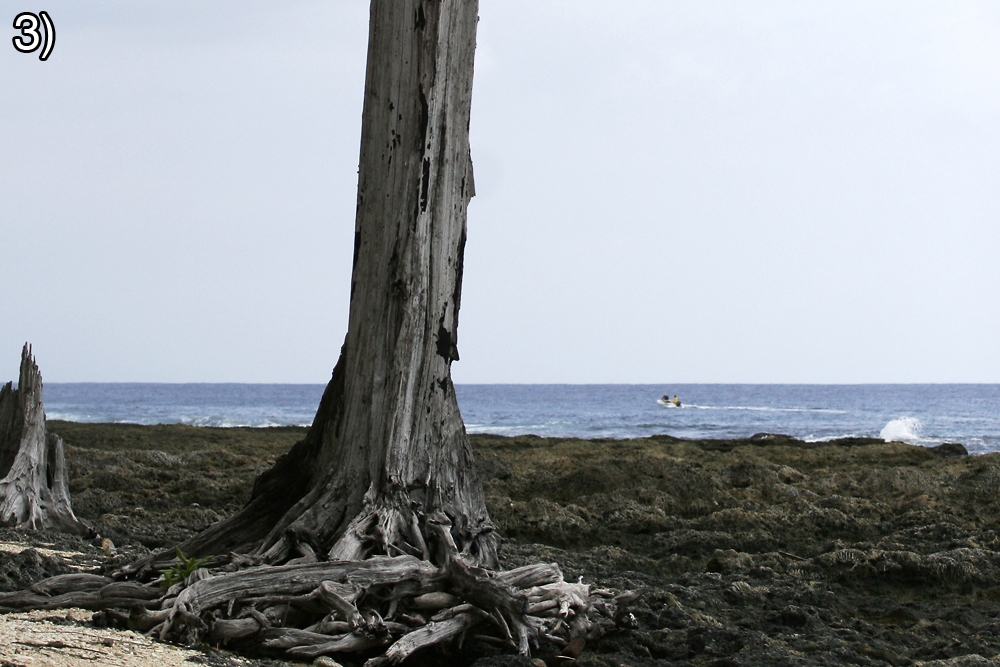The Mentawai Islands: The Rise and Fall of a Surfing Wonderland
 In this series Swellnet has been exploring the changing nature of coastlines. In the last installment we examined the sand movement that threatens to destroy the famous lefthander at Skeleton Bay, Namibia. This time we take a look at the Mentawai Islands and the volcanic processes causing the famed coral reefs to slowly sink and then rapidly rise.
In this series Swellnet has been exploring the changing nature of coastlines. In the last installment we examined the sand movement that threatens to destroy the famous lefthander at Skeleton Bay, Namibia. This time we take a look at the Mentawai Islands and the volcanic processes causing the famed coral reefs to slowly sink and then rapidly rise.
In the early 1990's only a handful of surfers had travelled to the Mentawai Islands. The location and quality of the waves in the northern Indonesian island chain was a closely guarded secret, so much so that an early magazine trip withheld details calling them 'The Incredible Sinking Islands'. The name was fitting, for the Mentawai Islands are indeed sinking, it's happening at an alarming rate and the only thing that will stop it is a great and destructive earthquake.
The Mentawais lie off the West Sumatran coast in one of the most tectonically active regions on the planet, tenuously placed on the edge of a subduction zone called the Sunda megathrust. Subduction zones are characterised by one tectonic plate sliding under the other, with the area where the two plates make contact known as a megathrust fault. In the case of the Sunda megathrust, the Indo-Australian plate is moving north-east and subducting under the Sunda plate at a rate of six centimetres per year.
In reality one plate doesn't simply slide under the other like an escalator. The megathrust actually remains locked in position with the Earth's crust deforming and building up pressure around the area until finally it gives way. The plate on top dips down as it has nowhere else to go with the attached land masses dipping down with it. The visible result is coastal inundation past the intertidal zone.
This process occurs over many years until eventually the plate on top, bowing down with extreme pressure, can no longer hold and fails. When this happens the plate 'springboards' back in an upwards fashion, causing a large displacement of mantle and crust and huge under sea earthquakes. These earthquakes, which usually run from deep sub-sea trenches, in turn cause a terrifyingly destructive tsunami that can travel many thousands of kilometres.
The 2004 Boxing Day Tsunami that claimed hundreds of thousands of lives occurred when a 1,600km stretch of the northern section of the Sunda megathrust ruptured between Aceh and Myanmar. The epicentre of the resulting 9.2 magnitude earthquake was just north of Simeulue. Recordings of uplifted coral on the reefs surrounding Simeulue showed that the land had risen by as much as 1.5m when the pressure was released by the megathrust.
This event was followed by another earthquake in March 2005 that measured 8.6 with an epicentre just offshore from Nias. In that earthqauke the reef at Lagundri Bay, Nias, was lifted 2.9m transforming the quality of the wave. Many other waves in the vicinity were also altered when their reefs were were pushed upward.

One of the pioneers of the Mentawai Islands and captain of the Barrenjoey, John McGroder, has noticed the changes. "Reefs have risen and dropped in my time in the Shakey Isles," says McGroder. "Most notably up North in the Nias and Simelue region after the 2005 Nias earthquake. Waves like Grubbies you can no longer ride for over a minute. Bawa is also a different monster when it is big."
Yet before the reefs and land were jolted upward the region was slowly sinking. Low lying coconut fields, rice paddies and other inhabited areas of the coast were being inundated as the region bowed down towards the megathrust fault.
Scientists believe we won't see another great earthquake event occurring anytime soon in the Sumeulue and Nias area because it takes centuries for tectonic plates to build up the stresses again. The area to the south, however, is another story.
Earthquakes the size and intensity as the 2004 and 2005 events occur approximately every two hundred years and the last time the Mentawai region saw any significant earthquake activity was in 1833. This has been deduced by analysing ancient coral structures known as microatolls in a process not unlike reading the age of trees through tree rings.
 Despite the activity to the north the whole middle section of the Sunda megathrust – the region containing the Mentawai Islands – is still sinking as pressure builds and the coastlines submerge. Macaroni's on North Pagai Island is a glaring example of coastal submergence. The headland behind the 'funnest left in the world' is slowly being swallowed up, with saltwater inundation causing the local flora to die; evident in the ghostly palms seen in the background of many a surf clip shot there.
Despite the activity to the north the whole middle section of the Sunda megathrust – the region containing the Mentawai Islands – is still sinking as pressure builds and the coastlines submerge. Macaroni's on North Pagai Island is a glaring example of coastal submergence. The headland behind the 'funnest left in the world' is slowly being swallowed up, with saltwater inundation causing the local flora to die; evident in the ghostly palms seen in the background of many a surf clip shot there.
There have been a few minor releases of pressure in recent times, with an 8.2 magnitude quake centred 200km south-east of the Mentawais in September 2007 raising selected regions of coastline. John McGroder was in the area and recounts his experience of the earthquake:
"There were two earthquakes. One at 6pm while Barrenjoey was anchored in the bay at Maccas. We got out of there in a hurry and steamed slowly down to Thunders. The next earthquake happened at 8am in the morning. There were four boats at Thunders and surfers in the water. The surf was very small. We all moved our boats into deeper water and got the guys out of the surf. They actually were getting shaken on their boards."
"After that it was all a matter of waiting to see if a tsunami happened. After a few hours we noticed the tide seemed a lot lower than normal. We went ashore and there were dying fish caught in puddles, live coral that should have been in the water, and great cartoon like cracks in the reef. The locals were scared and described the night as if something was coming out of the ground...pretty well sums it up for me."
These earthquakes, along with the more destructive 2009 quake which claimed over a thousand lives around Padang, are only small releases of pressure along the megathrust. The islands as a whole are still sinking with breaks like Macaronis, HT's, Rifles along with them.
 The question of how long these famous waves will keep their current shape is anyone's guess. Perfectly shaped waves reflect the form of the reef below and even small changes can alter them. Owing to scientific predictions the next great earthquake may not be too far away, and following that we'll see a much different wave scape across the Mentawais.
The question of how long these famous waves will keep their current shape is anyone's guess. Perfectly shaped waves reflect the form of the reef below and even small changes can alter them. Owing to scientific predictions the next great earthquake may not be too far away, and following that we'll see a much different wave scape across the Mentawais.
Kerry Sieh is a former professor of Geology at the California Institute of Technology and current AXA-Nanyang Chair in Natural Hazards at the Earth Observatory of Singapore. He has warned that a rupturing of the Sunda megathrust off the Mentawai Island chain is high likely within the next few decades.
"The great earthquake could happen tomorrow or thirty years from now," Kerry has stated, "but it is not likely to be delayed much beyond the next few decades." Further research reveals that the pressure accumulated along this stretch of the megathrust has now approached or even exceeded the levels relieved in 1833 and the last big quake before that in 1797. This seemingly makes the Mentawai Islands a ticking time bomb.
When the megathrust does rupture the resulting tsunami could, and most likely will, be catastrophic. After the dust settles it's assumed that areas currently sinking will have been forced upward to a higher level as was seen at Nias and Thunders. Whether this results in future discoveries being made throughout the Mentawai Islands is merely a side note, let's just hope the loss of life associated with these events is minimal. /
/CRAIG BROKENSHA & STU NETTLE
Image 1: Aerial view of Macaronis (Surfaid/Smith) Image 2: Coastal examples of seismic activity (Sieh) Image 3: Saltwater intrusion causing death of coconut tree (Brokensha) Image 4: Uplifted reef at Thunders (Brokensha)


Comments
His actual prediction is for a maximum 8.8 in western Sumatra sometime in the next few decades......but it is only a prediction and earthquakes are notoriously difficult to predict. I couldn't locate any primary references so I don't know what data he used. Historical data, such as that quoted,is only the roughest guide and even detailed studies can only reveal the potential. I think geologists, like doctors, often go for the worst case scenario on the basis that over-estimation is the lesser of the evils. Personally, given the history of the area, I think he is very brave to even put an upper limit. It is probably based on the maximum length of the rupture his data suggests is possible but there is a lot we don't know about this whole region and its history suggests a great capacity for surprise.
Given the low population density of the islands themseves the most significant danger is of a tsunami striking the coast of Sumatra itself in a densely populated area such as Padang. The short distance from the trench to the coast means there would be minimal warning time. Education is probably the only realistic defence. In Aceh most people did not know to move to higher ground after the earthquake. Hopefully the Indonesian government and charitable groups like Surfaid have made some progress since then.
The ultimate fate of the islands is to become part of mainland Sumatra as an accretionary wedge prevents further subduction and sedimentation turns the shallow stretch of sea from the coast to the islands into a plain, but we won't be around to see that!
Having surfed Nias back in '78 and the early 80s, and having been fortunate to avoid earthquakes / tsunamis and malaria, or death on the 'roads', it's sobering to read of the incredible natural forces at play along that coastline. In respect of concerns re future wave quality from islands rising and/or sinking, I'd also add that sea level is rising, and will likely rise at an increasing rate over coming decades as the warming oceans continue to expand and ice shelves melt. This will add a metre of more water over this century. At the same time, the ability of the major reef-builders, the stony corals, to keep pace, is being undermined by a range of impacts, from local pollution changing water quality, to the regional - global issues of high temperature bleaching and changes in ocean chemistry or 'acidification' - both driven by our continuing insatiable combustion of fossil fuels. How all these different forces play out for the waves of the Mentawi Islands is anyone's guess. Perhaps rising sea level will counterbalance rising islands, perhaps not.
I was talking to a seismologist from Surfaid who said the Boxing day quake relieved about half the pressure. Its due to go again at some stage, its just a matter of time....
Surfaid have their own seismologists? That's awesome!
lindo the reefs around the Mentawais have never recovered from the damage done in the late 90s and so have very little, if any, short term capacity to adjust. This is a good explanation of what happened.
http://earthobservatory.nasa.gov/Features/CoralDeath/
Thanks blindboy, I was aware of the '97 IOD - El Nino impact, but not the lack of recovery. Typically 15 years is plenty of time for corals to recruit and reestablish significant cover in places where they previously flourished. The fastest such recovery documented(6 years) is further E along the Indo isl chain, on a lava flow in the Banda Islands. Do you know how widespread the lack of recovery is across the region?
Sorry lindo but I am not aware of any recent data. If I get time I might try my research skills but I am guessing there has not been anything significant done. It would be a good crowd science project to get all the boat captains to photograph quadrats on the different reefs over a few years and download it all to someone doing a Ph.D.
Good idea re the photo quadrats blindboy, and there's likely to be a lot of useful anecdotal information there among the long-time boat skippers. Possibly some Reefcheck transect data were collected from the area during the Quiksilver Crossing years. I'll see what I can find out on that front. The Indonesian Institute of Sciences P20-LIPI have a few of their long term monitoring sites there as well, but no geographically-comprehensive surveys that I'm aware of.
I have a hard time imagining climbing a palm tree in the middle of the night as a survival tactic. In case you survive and the palm tree remains intact, what is the next step?
Anyone know how you say/yell 'HELP!' in Indonesian?
Will be there April-June. Send flotation devices.
Z-man, I've heard stories where some of the local people hike up into the mountains with a couple of months of supplies, live their until it's all gone and then hike back down to stock up and do it all again.
Also Surfaid's Dr Dave Jenkins understanding is this that we are 5 years behind in the 200 year cycle so is expecting "the call" at any given moment. He's hoping it doesn't happen before they can roll out their emergency preparedness program to more Mentawai villages (all depends on funding).
craig, no offense but you cannot claim to be "5 years behind" on the 200 year cycle since if you look at the data it is only a very rough cycle and could be expected to vary by more than that. The science of earthquake prediction is limited and unreliable. More large earthquakes in the region are probable in the medium term is about all the science strictly allows to be said.
z-man, in the absence of any better options climb that palm tree! People survived the Aceh event doing that and given the speed with which a tsunami can advance across flat terrain it is a better option than trying to run away. If the palm tree comes down then you have something to hang onto. Many people in Aceh survived by clinging to whatever floating debris they could grab. I thought Surfaid's strategy was to persuade villagers to move permanently to higher ground.
Totally agree blindboy, but what I was getting at is that Dave believes we are already overdue (while in the article above I've stated that it's a very high possibility in the next few decades).
Excellent article Craig. I enjoyed the Skeleton Coast article as well, looking forward to the next installment.
I did a trip to the southern Ments in 2010, surfed HT's. I was curious about the Hollow Trees in the shoreline, they did not appear natural to that location, which suggested to me the coastline was pinched/ing down. I interviewed our Japanese guide You-ie, who felt the coastline had retreated about 50m (my estimate, based on his description of house and well, since washed away) in the space of 11 years. Not sure if HT's is better of worse. We surfer another left far to the south called.... ahhh...SecretSpot - which, according to my research - did not exist as a valid surf spot till 2010.
Surfed Simeulue in September 2005, some months after the earthquakes, at a spot called Ali's - reef was clearly lifted up (my estimate +2m), dry out of the water, could still see and smell rotting coral. Radical. To my understanding, the right was suckier and the ride shorter - post quake. While other nearby breaks, were goneski. Two earth tremors while we were there, the coastline is constantly on the buckle. Unique places.
Thanks Andrew. Yeah the subsidence is really obvious at some locations and the western coasts of the Mentawai Islands are actually sinking at a greater rate than the opposite (eastern/Sumatran facing) coasts of the islands.
What was the smell like from the dying coral? Rotting fish or more just a rotting dying odour in general?
The Sunda Megathrust has been very activity in the last few hours with a series of earthquakes felt offshore from Sumatra. Most have been located between Banda Aceh and the Nicobar Islands though some have also been reported NW of Nias. There have been no tsunami alerts issued yet.